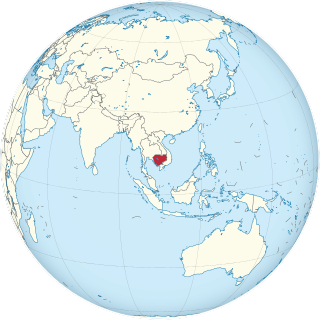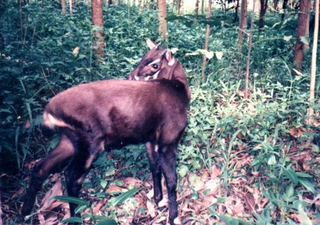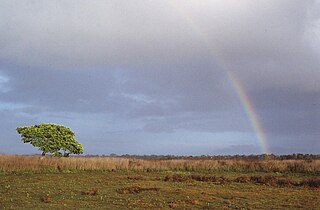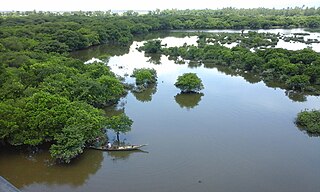
Cambodia is a country in mainland Southeast Asia, bordering Thailand, Laos, Vietnam, the Gulf of Thailand and covers a total area of 181,035 km2 (69,898 sq mi). The country is situated in its entirety inside the tropical Indomalayan ecozone and the Indochina Time zone (ICT).

Phong Nha-Kẻ Bàng is a national park and UNESCO World Heritage Site in the Bố Trạch and Minh Hóa districts of central Quảng Bình Province in the North Central Coast region of Vietnam, about 500 km south of Hanoi. The park borders the Hin Namno Nature Reserve in Khammouane Province, Laos to the west and 42 km east of the South China Sea from its borderline point. Phong Nha–Kẻ Bàng National Park is situated in a limestone zone of 2,000 km2 in Vietnamese territory and borders another limestone zone of 2,000 km2 of Hin Namno in Laotian territory. The core zone of this national park covers 857.54 km2 and a buffer zone of 1,954 km2.

Most of Kerala, whose native habitat consists of wet evergreen rainforests at lower elevations and highland deciduous and semi-evergreen forests in the east, is subject to a humid tropical climate. however, significant variations in terrain and elevation have resulted in a land whose biodiversity registers as among the world’s most significant.

Bhitarkanika Mangroves is a mangrove wetland in Odisha, covering an area of 650 km (400 mi) in the Brahmani and Baitarani river deltas.

Los Flamencos National Reserve is a nature reserve located in the commune of San Pedro de Atacama, Antofagasta Region of northern Chile. The reserve covers a total area of 740 square kilometres (290 sq mi) in the Central Andean dry puna ecoregion and consists of seven separate sections.

The wildlife of Vietnam is rich in flora and fauna as reflected by its unique biodiversity. Rare and endemic antelope-like animal, categorized under the bovine subfamily, was found in 1992, in Bạch Mã National Park. In the 1990s, three other large mammal species, the deer-like Truong Son muntjac, giant muntjac and Pu Hoat muntjac, were also discovered, the first two in the same park. Conservation protection and scientific studies of the ecology of Vietnam, particularly in the protected forest areas, have been given priority attention by the Government of Vietnam. Laws were enacted to set up Xuân Thủy Wetland National Park, four UNESCO Biosphere Reserves, and Hạ Long Bay and Phong Nha-Kẻ Bàng National Parks; the last two are also designated as UNESCO World Heritage Sites.
The Green Corridor of Vietnam is the international and national project name for one of the last remaining lowland wet evergreen forests, and supports significant populations of threatened species. It is located in Thừa Thiên–Huế Province, and is also part of Vietnam's Annamite Mountain Range. The area includes some of the longest remaining stretches of lowland river with intact forest habitat in Vietnam, which feed into the Perfume River. The rainforests of the Central Annamites likely existed as continuous undisturbed forest cover for thousands of years, and, as a result, offer unique habitats for many species. The name "Green Corridor" originates in preparatory project documents of the WWF.
Kon Ka Kinh National Park is a national park of Vietnam, established by the decision (167/2002/QĐ-TTg) on November 25, 2002 of the then Prime Minister, Phan Văn Khải.

Tsimanampetsotsa National Park also spelt Tsimanampetsotse, and known as Tsimanampetsotsa Nature Reserve is a 432 km2 national park on the south-west coast of Madagascar in the region Atsimo-Andrefana. The park is 90 kilometres (56 mi) south of Toliara and 950 kilometres (590 mi) south of the capital, Antananarivo. Route Nationales (RN) 10 to Faux Cap passes the park and the nearest airport is at Toliara.

Bao BolongWetland Reserve is a national park in The Gambia. Established in 1996 it covers 220 square kilometres.

The Wasur National Park forms part of the largest wetland in Papua province of Indonesia and has been one of the most disturbed by human activity. The high value of its biodiversity has led to the park being dubbed the "Serengeti of Papua". The vast open wetland, in particular Rawa Biru Lake, attracts a very rich fauna.

The Stung Treng Dam is a proposed hydroelectric dam on the Mekong River in Stung Treng Province, Cambodia. It would be located on the mainstream of the Lower Mekong River. The project is controversial for several reasons, including its possible impact on the fisheries, as well as other ecological and environmental factors.

Đồng Tháp Mười is an inland wetland in Vietnam's Mekong Delta. Most of the wetlands are within Long An Province and Đồng Tháp Province.

Many areas of Vietnam are under protection. While the national reserves cover small areas of scientific significance with restricted access, the national parks also cover wetlands of Ramsar designated areas and BirdLife International inscribed bird areas. The largest of the national parks initially covered were the Cúc Phương National Park, the Cát Tiên National Park, and the Côn Đảo National Park which to start with were forest areas cum reserves or prohibited areas. The objective for creating national parks was to allow access to the reserved areas as a part of ecotourism and cultural needs with full attention to the basic approach of conservation of natural environmental resources.

The Cheetham Wetlands are 420 hectares of artificial and natural lagoons, created on old salt works land on the western shores of Port Phillip Bay, Australia. The wetlands are approximately 20 kilometres (12 mi) southwest of Melbourne, and sit within the Municipal Councils of Hobsons Bay and Wyndham City.

Wildlife of Ukraine includes its diverse fauna and flora. The reported fauna includes forty-five thousand species including the areas of the Black Sea and the Sea of Azov. Protected areas consist of 33 Ramsar sites covering an area of 7,446.51 square kilometres (2,875.11 sq mi). Biosphere nature reserves and three national parks are all part of the GEF projects portfolio of conservation of biodiversity in the Danube Delta. Their vegetation pattern is Mixed Forest area, Forest-Steppe area, Steppe area, Ukrainian Carpathian Mountains and Crimean Mountains. Some of the protected areas which were reserves or parks are subsumed under the biosphere reserves.

The Point Cook Coastal Park covers an area of 863 hectares and includes the Cheetham Wetlands. The park extends from the RAAF Williams Point Cook Base northeast along the coast to the Laverton creek which comprises its northern boundary. The park is approximately 20 kilometres (12 mi) from Melbourne in a southwesterly direction along Port Phillip Bay. The park is adjoined by the Point Cook Marine Sanctuary, which extends around the point to the south and the east. The northwestern boundary to the park is residential housing.

The espinal (NT0801) is an ecoregion of dry, thorny forest, savanna and steppe in Argentina. It has been extensively modified by large scale cattle ranching, but remnants of the original flora remain. It is threatened by the advance of the irrigation-based agricultural frontier.





















